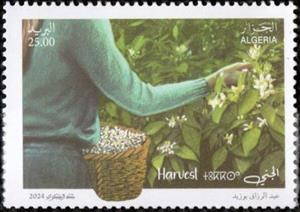Stamp: Harvesting Blossoms (Algeria 2024)
Harvesting Blossoms (Algeria 2024)
03 June (Algeria ) within release Orange Blossom Water Production (2024) goes into circulation Stamp Harvesting Blossoms face value 25 Algerian dinar
| Stamp Harvesting Blossoms in catalogues | |
|---|---|
| Colnect codes: | Col: DZ 2024.06.03-01 |
Stamp is horizontal format.
Also in the issue Orange Blossom Water Production (2024):
- Stamp - Distilling Orange Blossom Essence face value 25;
- Stamp - Drying Blossoms face value 25;
- Stamp - Harvesting Blossoms face value 25;
- Stamp - Packaging Orange Blossom Water face value 25;
- Souvenir Sheet - Stages of bitter orange blossom water prodution face value 100;
Stamp Harvesting Blossoms it reflects the thematic directions:
Agriculture is the cultivation and breeding of animals, plants and fungi for food, fiber, biofuel, medicinal plants and other products used to sustain and enhance human life.[1] Agriculture was the key development in the rise of sedentary human civilization, whereby farming of domesticated species created food surpluses that nurtured the development of civilization. The study of agriculture is known as agricultural science. The history of agriculture dates back thousands of years, and its development has been driven and defined by greatly different climates, cultures, and technologies. Industrial agriculture based on large-scale monoculture farming has become the dominant agricultural methodology.
A flower, sometimes known as a bloom or blossom, is the reproductive structure found in plants that are floral (plants of the division Magnoliophyta, also called angiosperms). The biological function of a flower is to effect reproduction, usually by providing a mechanism for the union of sperm with eggs. Flowers may facilitate outcrossing (fusion of sperm and eggs from different individuals in a population) or allow selfing (fusion of sperm and egg from the same flower). Some flowers produce diaspores without fertilization (parthenocarpy). Flowers contain sporangia and are the site where gametophytes develop. Many flowers have evolved to be attractive to animals, so as to cause them to be vectors for the transfer of pollen. After fertilization, the ovary of the flower develops into fruit containing seeds. In addition to facilitating the reproduction of flowering plants, flowers have long been admired and used by humans to beautify their environment, and also as objects of romance, ritual, religion, medicine and as a source of food.


